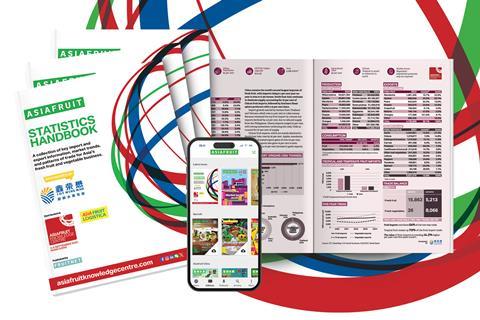Asiafruit Statistics Handbook 2025 provides expert analysis of key trends in trade across 12 different Asian markets

Asia’s total fresh fruit imports grew in 2024, driven by stronger intra-Asian trade in durians and other tropical fruits as market demand from China increased. That is one of the headline trends in Asia’s fresh produce trade highlighted in the Asiafruit Statistics Handbook 2025.
Published by Fruitnet, the annual statistical guide to Asia’s fresh produce trade was launched at Asiafruit Knowledge Centre at Asia Fruit Logistica on 3-5 September 2025 in Hong Kong.
Access the digital version here.
Asian markets imported 17.3mn tonnes of fresh fruit from all origins in 2024, marking a 10.2 per cent increase on the previous year, according to analysis in the Asiafruit Statistics Handbook 2025.
Intra-Asian fruit trade continued to dominate the region’s markets in 2024, expanding by 13.7 per cent to reach 12.5mn tonnes and accounting for nearly three-quarters (72.5 per cent) of Asia’s total import trade.
The intra-Asia trade is underpinned by strong demand for temperate fruit from the warm-climate markets of South-East Asia, largely supplied by China, and for tropical fruit – including durians, bananas, and dragon fruit – supplied by South-East Asian producers to North Asian markets.
China the central player
China remains the region’s central player, both as the largest importer and exporter of fresh fruit. Imports climbed 8.1 per cent to 6.3mn tonnes, driven by a 29 per cent surge in cherry shipments from Chile and a 9.4 per cent increase in durian sendings from Thailand and Vietnam. On the export side, volumes rose sharply by 30 per cent to 4.7mn tonnes. Mandarins remained China’s leading fruit export, recording a further 20 per cent gain, while apple exports increased 23 per cent, pears by 34 per cent, and grapes by 23 per cent.
Supplies from outside Asia also grew, extending recent strong trade trends. South American exports to Asia rose 8 per cent to 1.04mn tonnes, including more than 500,000 tonnes of Chilean cherries shipped primarily to China, alongside increased avocado exports from Peru and apple shipments from Chile. Australia and New Zealand registered a combined 16 per cent increase to 1.12mn tonnes, supported by a rebound in kiwifruit after the poor 2023 season and strong gains in counter-seasonal citrus and stonefruit exports.
By contrast, exports from Southern Africa declined 6.6 per cent to 677,000 tonnes, reflecting a smaller orange crop. Imports from the Middle East and North Africa also fell, down 9 per cent, with lower Egyptian citrus shipments partially offset by increased apple supplies from Turkey and Iran, particularly into India.
North American shipments showed signs of recovery. Imports from the US and Canada grew 4.5 per cent to 611,000 tonnes after a weather-affected year, though logistics challenges and competition from Asian production remain headwinds.
Central American banana shipments held steady at 577,000 tonnes, while China continued to diversify its banana supply across both South-East Asian and Central American origins.
Growth in SE Asia and India
Within Asia, Vietnam recorded one of the strongest increases, with imports surging 38 per cent to 1.9mn tonnes, surpassing Japan as the region’s second-largest importer after China. Much of this trade was made up of mandarins and apples from China as well as rapidly growing imports of mangoes and mangosteens from Cambodia, though a significant share is re-exported.
Other South-East Asian markets also expanded. Indonesia’s fruit imports rose 14 per cent to 700,000 tonnes, driven by Chinese citrus and grapes, while Thailand’s imports grew 15 per cent to 657,000 tonnes, again largely made up of citrus, grapes, and apples from China.
India’s imports climbed by 7 per cent to 864,000 tonnes, led by apples from Iran and Turkey and oranges from Egypt. A standout trend was the sharp rise in avocado imports, which jumped 134 per cent to over 9,000 tonnes, primarily supplied by Tanzania.
The Asiafruit Statistics Handbook presents informed analysis, helping the fresh produce industry to make sense of production, supply, and patterns of trade across 12 different Asian markets.
Access a free copy of the Asiafruit Statistics Handbook 2025 here.



